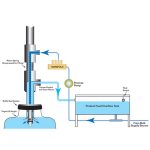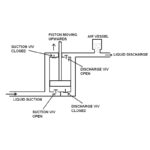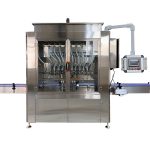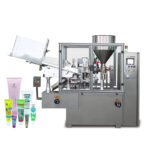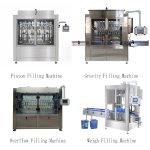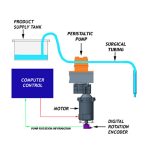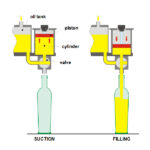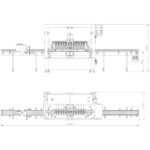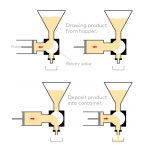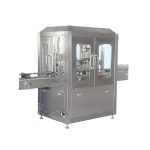Gravity filling is the simplest filling method. The uncomplicated construction and operation of gravity filling machines permits them to run with a minimum of maintenance. The supply tank (more properly called the filler bowl) is the upper, central part of the machine. Filling stems are attached to the bottom surface of the bowl at each container filling point. A vent tube extends upward into the filler bowl to a point above the liquid level. To begin the filling operation, the container is raised by the platform until it contacts the filling stem. The platform then continues to raise the container against the stem, opening the filling valve. With the filling valve open, the liquid drains into the container. The air in the container flows out trough the vent tube into the space above the liquid in the filler bowl. Although the container becomes filled, the liquid continues to flow in. The excess fluid rises in the vent tube until it reaches the same height as the liquid level in the bowl. Because the vent tube extends above the bowl liquid level, there is no overflow of liquid from the container into the bowl.
Gravity Filler Principle
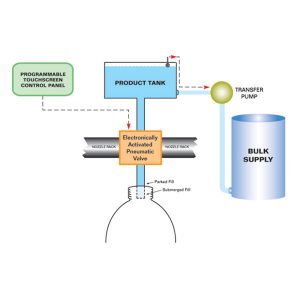
How It Works:
The product bulk supply is pumped into a holding tank above a set of pneumatically operated valves. Each valve is independently timed by the filler’s master computer so that precise amounts of liquid will flow by gravity into the container. Gravity fillers built with bottom up fill capability can handle a wide range of flowable liquids including foamy products.
Application:
This type of filler is best suited for liquids with very thin viscosities that do not change with ambient temperature or with batch variation. This machine is also suited for applications where recirculation of the liquid in the fluid path is not desireable. Although this type of filler is used predominantly on products that do not foam, foam may be limited and controlled by subsurface/bottom-up-fill capability.
Examples:
Water, solvents, alcohol, specialty chemicals, paint, inks, corrosive chemicals i.e. acids and bleach.
Advantages:
This is the most economical type of filling machine for a limited range of applications. It is especially well suited for corrosive chemicals.
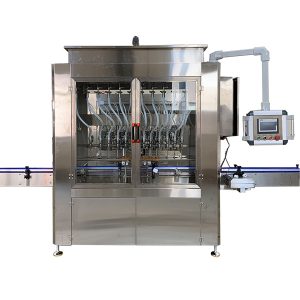
VK-GF Automatic Gravity Chemical Bottle Filling Machine
Read More
When product reaches the vent tube the excess recirculates back into the product tank. The cycle of the gravity filler is time-controlled and fully adjustable. When the cycle completes, the fill head elevates, the fill valves close and the neck guides retract. Finally, the pneumatic front gate releases allowing your filled containers to exit. The product level in the tank is managed by sensors controlling a pump which will pump product into the tank from your supply.
If the product is foamy, the foam will rise in the vent tube above the liquid level in the bowl. If it is stable foam and will not break down, it will ultimately overflow into the bowl. For this reason, gravity fillers are not often used for foamy products. At the predetermined time after the container is filled, it is lowered from its filling position, closing the filling valve. Liquid left in the filling stem is removed from the vent tube in several ways.
Gravity Filler
While overflow fillers will allow a packager to fill to a level, gravity filling machines let a packager fill each bottle with the same volume of product using a time based filling principle. Once again referring to the discrepancies in the interior volume of containers, a gravity filler will ensure that each bottle containers the same amount of product, even if this results in some containers looking more filled or less filled than others.
While gravity filling machines can use a number of different nozzles, generally speaking the nozzles will open for a pre-set amount of time to allow product to flow from a tank into the waiting bottles or containers. On most machines, the fill time for each individual head or nozzle can be adjusted to allow for greater accuracy. Times can also be set to fractions of a second to also improve volumetric accuracy. Once the pre-determined time has been reached, the nozzles will cut off the flow of product. For semi-automatic machinery, simple operator activated switches are used to activate the cycle, while automatic machinery will use a PLC to achieve the same.
The choice to use a fill to level system or a fill by volume system will always depend on the characteristics of the unique project at hand. For packagers using clear containers, the trend is toward the overflow principle, allowing for an increase in shelf appeal and aesthetic value as a result of the level fills. For packager not using opaque containers, the gravity filler may offer a better alternative, especially when consistent volumes are important to the industry. But even exceptions to these rules may apply where containers or product themselves are unique. The best advice for a new packager is to not only know, but understand, the different options that are available for packaging your own unique product before selecting any packaging machinery.
